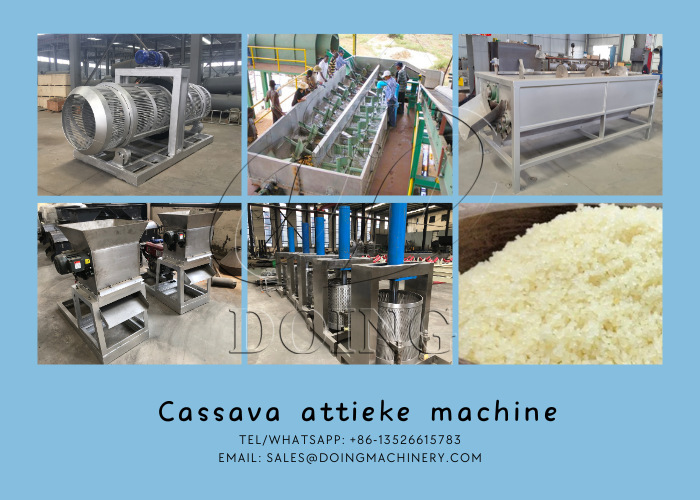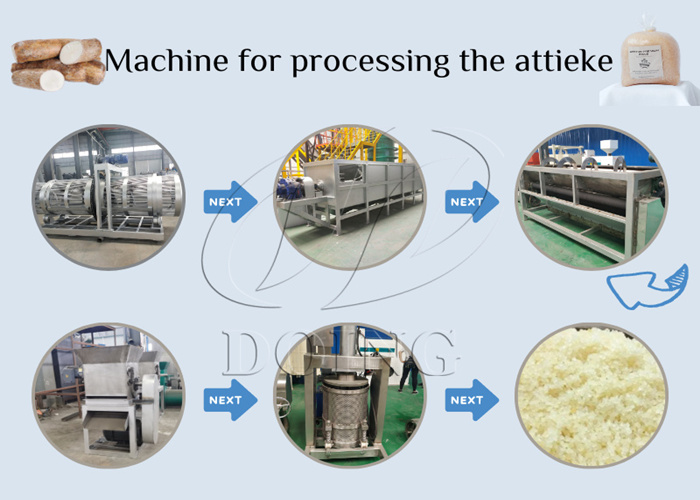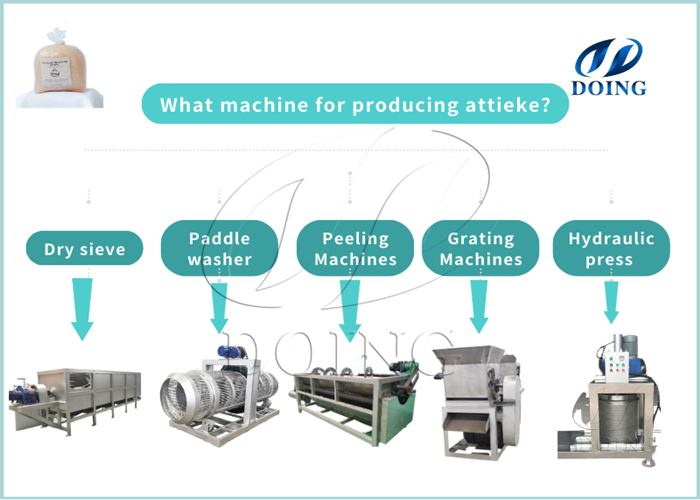Blog
 2025-03-19
2025-03-19Attieke is a beloved traditional African food made from cassava, known for its unique texture and flavor. This staple dish is not only delicious but also highly nutritious, making it a popular choice across various African cuisines.
In this comprehensive guide, Henan Jinrui, the professional cassava processing equipment manufacture, will walk you through the process of transforming cassava into attieke, covering each step in detail to ensure the perfect transformation of cassava to attieke.
The process to making attieke begins with selecting the right cassava tubers. Fresh, mature cassava is essential, as it ensures the best flavor and texture. Choose tubers that are firm and free from obvious damage or rot. The outer skin of cassava contains cyanogenic glycosides, which can be toxic if not properly removed, so thorough peeling is crucial for the transformation of cassava to attieke.
 Complete cassava attieke processing machines
Complete cassava attieke processing machines
Cleaning: Rinse the cassava tubers thoroughly under running water to remove dirt and impurities from the surface of the cassava. This step is essential to ensure a safe and contaminant-free in attieke production process. In order to achieve better cleaning results, we can use Henan Jinrui Design Paddle Washer, which adopts a countercurrent washing design to effectively remove impurities such as mud and sand from the cassava raw materials.
Peeling: The peeling process is to remove the toxicity of the cassava skin, and it is also a key step in ensuring the high quality of attieke production. Using appropriate peeling equipment can not only reduce the time of transforming cassava into attieke, but also ensure the peeling effect of cassava. For example, Henan Jinrui's peeling machine adopts sand roller design, and the peeling rate can reach 90%.
After the cassava is cleaned and peeled, the next step is to grind cassava into a fine pulp. This process breaks the cassava into smaller particles, which is essential for fermentation and the final texture of attieke. For small-scale attieke production, a manual mortar and pestle can be used to obtain a smooth pulp. However, for industrial attieke production, it is more efficient to use a professional grinder. The grinding machine provided by Henan Jinrui adopts roller crushing, which can achieve better grinding effect contributing to the successful transformation of cassava into attieke.
Fermentation is a key step in the transformation of cassava into attieke, as it develops the dish's distinctive flavor and texture. The process involves letting natural bacteria break down the cassava pulp, producing a tangy and slightly sour taste. The pulp is placed in a clean, covered container and allowed to ferment for 1 to 3 days. The duration may vary depending on factors such as temperature and humidity. During this time, the pulp will develop its characteristic flavor and texture.
 Machines for processing the attieke
Machines for processing the attieke
After fermentation, the cassava residue needs to be dried to reduce its moisture content. This step is essential for preserving attieke and achieving the desired granular texture. The traditional drying method for attieke production is to spread the fermented cassava residue evenly on a flat surface such as a tray or mat. Make sure the spread layer is not too thick to allow for proper drying. However, with this drying method, not only does it extend the time it takes to transform cassava into attieke, it also reduces the quality of attieke. Therefore, we can use the hydraulic press manufactured by Henan Jinrui for faster and more controlled drying to obtain high-quality attieke.
The final steps involve steaming and granulating the dried cassava to achieve the fluffy texture of attieke and a successful transformation of cassava to attieke. Place the dried cassava mush in a steamer basket over boiling water. Steam for about 10 to 15 minutes until the cassava mush is soft and fluffy. Steaming allows the dried cassava mush to reabsorb water and enhance its texture. Once the cassava mush has been steamed, break it into small particles using your hands or a fork. This step ensures that the attieke has a uniform texture similar to couscous.
 Complete Attieke Production Line
Complete Attieke Production Line
Once the attieke is ready, it can be shaped into small balls, cubes, or other desired forms. Pack the attieke in clean, airtight containers to preserve its freshness and quality. Proper packaging ensures that the attieke remains safe for consumption and maintains its texture and flavor.
Transforming cassava into attieke is a rewarding process that combines traditional techniques with modern efficiency. By following these steps and using suitable processing equipment, you can create a delicious and nutritious staple that is perfect for a variety of African dishes. In addition attieke production line, Henan Jinrui also provides garri making line, cassava flour and starch processing plant, if you have any demand, welcome to consult us! Henan Jinrui will service you wholeheartedly!
Want to know more about our products or services? Fill out the contact form below, and we’ll to get back to you and you will get the price list. Please also feel free to contact us by email or phone.( * Denotes a required field).